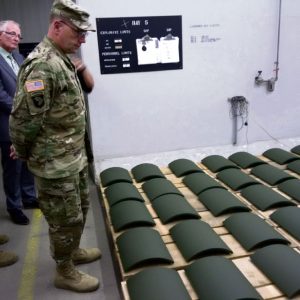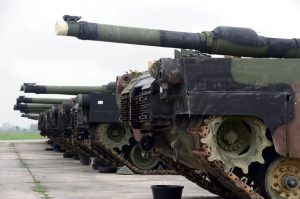
Lt. Gen. Ben Hodges, U.S. Army Europe commanding general, receives a briefing on the status of an ongoing, labor-intensive effort of Army Ammunition Center Europe to re-paint 13,000 reactive armor tiles from sand to forest green. The tiles are a critical defense against emerging threats and are being fielded to vehicles in the European Activity Set, which are used by regionally allocated forces throughout Europe. This effort is just one of many adaptive sustainment efforts by the Theater Logistics Support Center Europe in support of USAREUR and NATO operations throughout Europe.
The Miesau Army Ammunition Depot, located just to the west of Kaiserslautern, appears unassuming from the Autobahn and calling it a depot hardly does justice to the installation’s importance to U.S. Army Europe and NATO efforts.
While the depot does serve as the staging site for 25,000 tons of ammunition and held around 200,000 tons at the height of the cold war, much more than basic ammo passes through this critical hub of sustainment services.
The Army Ammunition Center Europe, a 21st Theater Sustainment Command unit that calls the depot home, performs a wide variety of munitions-focused sustainment efforts.
The center recently received a shipment of more than 12,000 reactive armor tiles that were painted in desert sand instead of forest green that matches the current fleet of military equipment in Europe.
The adaptive team at the ACE began the process of working with contractors to repaint the tiles to forest green, and like many efforts in sustainment, the process is not nearly as simple as it may seem. The tiles must be individually unpacked by hand, transported to a painting site, painted, allowed to dry and then transported back to a packing site where they are repacked. All of this must be performed according to stringent international safety and transport guidelines. Once completed, the tiles are ready to be mounted on combat vehicles.
“It’s a very labor-intensive process and involves a lot of moving pieces and very demanding quality standards, but it’s absolutely necessary,” said Gene Warren, Theater Logistics Support Center Europe deputy director, the higher headquarters of ACE. “We are in Europe, so for operational purposes, the tiles have to be green. The painting process just shows how adaptive and flexible the team of technical experts at the ACE are.”
The tiles represent a critical defense against emerging threats, and fielding them quickly has been a high priority for the commanding general of USAREUR, Lt. Gen. Ben Hodges, who recently visited Miesau to see the tile repainting and other ongoing efforts at the center. Painting enough tiles for one brigade combat team is expected to take about four months.
During the visit, Hodges stopped at several storage sites and was briefed on a variety of current efforts underway at the ACE.

A row of M1A2 Abrams tanks positioned at Coleman Work Site, Mannheim, are part of the European Activity Set inventory to support training in Europe. The Army Ammunition Center Europe, located in Miesau, is currently undertaking a labor-intensive effort to re-paint 13,000 reactive armor tiles which will be installed on this EAS equipment.
The reactive tile repainting effort is just one example of how the simple task of receiving, storing and issuing munitions in support of USAREUR and NATO can get very complicated very quickly.
The center will process 1,100 containers of ammunition this year and manages over 400 bunkers across 2,000 acres of land to store the ammunition. Of course, the process is not just as simple as storing the ammunition. It has to be closely tracked, and impeccable accountability must be maintained. Additionally, the center must adhere to stringent international safety standards when shipping and storing ammunition.
The center also receives ammunition residue, most commonly in the form of brass bullet casings, from supported units throughout Europe and reprocesses the residue. In another example of adaptive thinking, the center was able to set up a program to quickly reprocess and actually generate revenue for the government from ammunition residue.
The center employs just 228 local nationals and Department of the Army civilians across four sites. This relatively small but capable workforce includes experts in a wide variety of munitions and directly supports almost every major USAREUR operation, including regionally allocated forces and the European Activity Set as well as critical NATO operations like Operation Atlantic Resolve.
The center’s higher headquarters, the TLSC-E, is a brigade equivalent organization under the 21st Theater Sustainment Command. The depot was founded as the Rhine Ammunition Depot May 23, 1949, and was designated as a NATO ammunition depot under the U.S. Army and is the largest ammunition depot outside the U.S.
At the height of the Cold War, the Theater Storage Area had 200,000 short tons of ammunition and employed over 1,500 local nationals. Today the center has approximately 30,000 short tons of ammunition. The diverse local-national workforce within TLSC-E and ACE include over 10 national origins, and due to the long-term nature of their employment, some employees have 20-, 30- and 40-plus years of experience. This critical experience coupled with the intense internal procedures ensure a safe working environment directly contributing to the readiness of the Soldiers within USAREUR.


